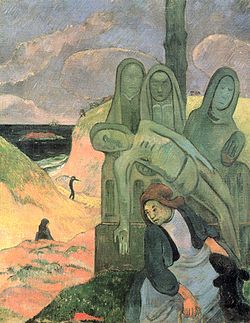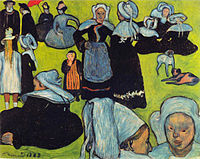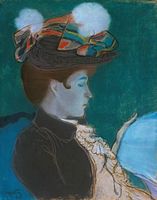综合主义
来自维基百科,自由的百科全书
综合主义(Synthetism),类似象征主义的19世纪后印象派美术主义。

概述

综合主义原本是一文学主义,其延伸至美术是因1889年,画家高更自号为“综合派画家”,综合主义才正式于美术风行。综合主义发展初期,与分隔主义有很大关联。后来才逐渐变得与象征主义有关。综合主义多使用特有的“隔色画法”,并且旨在表达观念、不同气氛和起伏情感,为自然主义的对立主义。画家绘画技巧多为综合不同印象和依组合其大脑中的记忆。因隔色画法的关系,色彩多为明亮并以黑线隔开不同颜色,目的是完成抽象且综合的作品。[1]
综合主义画家的特色
代表美术家

活跃于19世纪80至90年代
画廊
-
保罗·高更, Vision after the Sermon, 1888.
-
保罗·塞律西埃, The Talisman (with the forest landscape of love in Pont-Aven) 1888
-
保罗·高更, The Green Christ, 1889
-
埃米尔·贝纳, Breton Women in the Meadow, August 1888. Bernard exchanged this one with Gauguin who brought it to Arles in autumn 1888 when he joined Van Gogh, who was totally fond of this style. Van Gogh painted a copy in watercolor to inform his brother Theo about it.
-
梵高, Breton Women and Children, November 1888 (watercolor after Bernard).
-
路易·安昆廷, Reading Woman, 1890
参考
Wikiwand - on
Seamless Wikipedia browsing. On steroids.









